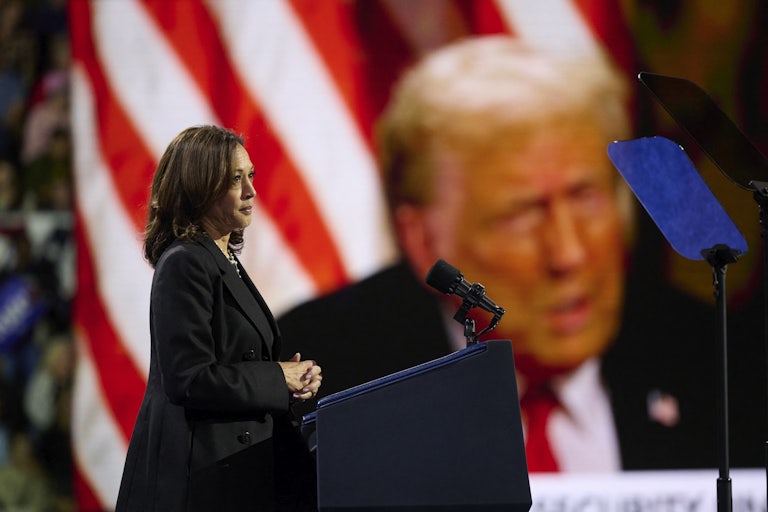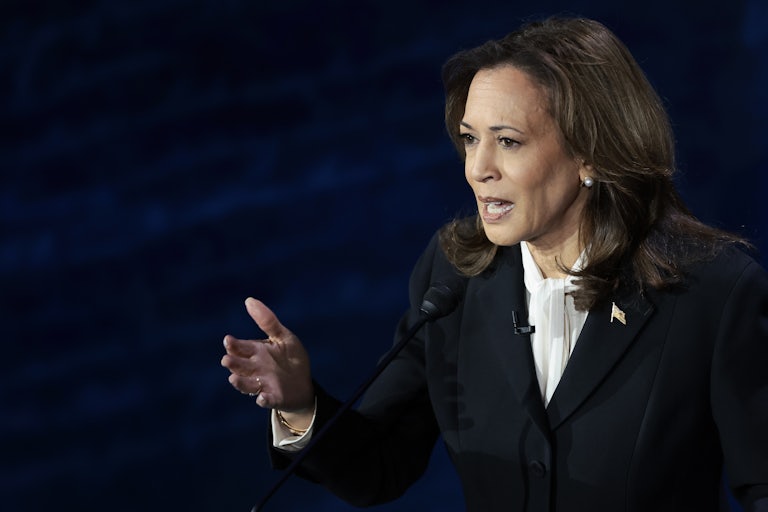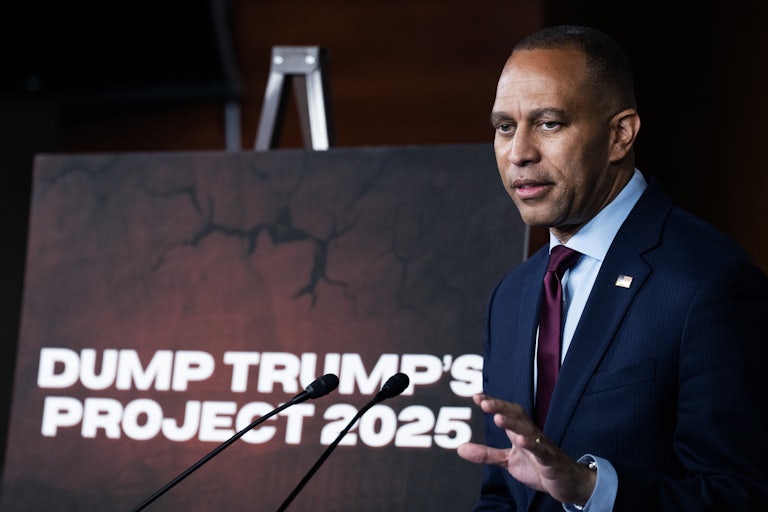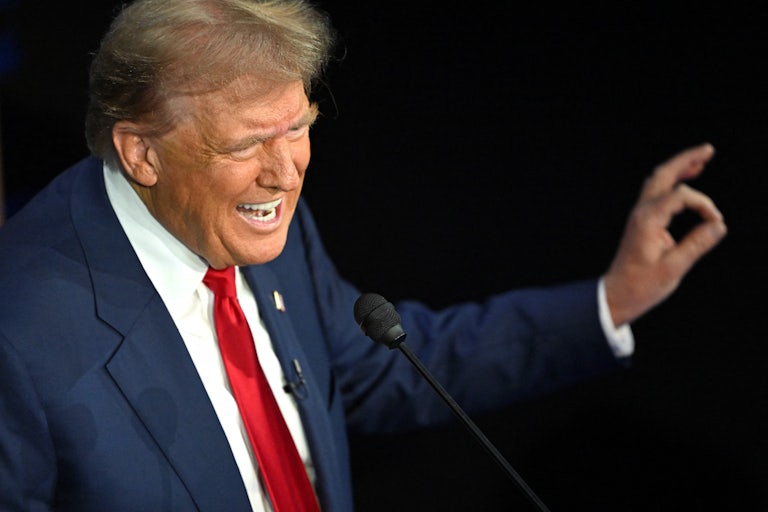A Cold, Hard Look Into Our Trumpian Future
The road ahead is filled with peril—for our fellow Americans, the Democratic Party, and Donald Trump himself.

Let’s begin with the simplest and most obvious observation: A majority of Americans prefer what Donald Trump has been selling over Kamala Harris. It’s hard to stomach, because this election offered a pretty clear choice between a cheerful and humane future and a rapturously brutish one. But the latter won out. More Americans wanted the 1939 German-American Bund–style hate rally at Madison Square Garden than the big-tent party with high ideals about the American constitutional order. And we can no longer reassure ourselves, as we did in 2016, that Trump voters didn’t precisely know what they were getting or that much of what he promised to do was not to be taken seriously. We know what he’s about now, and a majority of voters clearly want it.
The country is set to change in stark ways, as Project 2025 jumps from the pages of a far-right dream journal into our lives. There will be big rollbacks in the civil rights many of us have come to enjoy, causing disproportionate pain to women and members of the LGBTQ community. I feel terribly for all the people who voted to protect reproductive freedoms in their states because the effort may be all for naught. As we have relentlessly explained on TNR’s pages, Trump’s Department of Justice can create a national abortion ban by enforcing the Comstock Act, thus bypassing the legislative process and the will of voters entirely. Wherever reproductive rights have managed to secure a haven in a state constitution, those rights will be fought over in inhospitable venues, like the Supreme Court.
Trump’s signature policy proposal is a mass deportation scheme that will target legal citizens for “remigration” alongside the undocumented. The regulatory state will be transformed into something that serves corporations instead of the public. The civil service, as I have mentioned before, will be reconfigured into something that, at best, may look like the “spoils system” of yesteryear; more likely it will exist to dole out punishments to Trump’s political opponents. Imagine a world in which blue states don’t receive disaster relief; where Democrats don’t get their Social Security checks.
Part of Trump’s second-term agenda includes a plan to crush left-liberal organizing. The movement to end the war in Gaza, which was highly effective in shifting public opinion on Israel’s ongoing military assault, will feel this hammer blow first. Trump has been lately dogged by generals who opposed his fascist inclinations; his future generals will be much less reluctant. Supreme Court Justices Clarence Thomas and Samuel Alito will retire and be replaced by younger versions of themselves. Probably worst of all, the timeline on permanent climate catastrophe has moved up—it’s not unfair to say that we may soon arrive at a point of no return (though my strong suspicion is that we have reached it already).
At the moment, I can’t exactly figure out what kind of Democratic Party emerges from the wreckage of this election. Harris ran a distinctly centrist style of politics, for which influential members of the punditocracy and the party’s most entrenched elites had long agitated. This approach flopped, badly. This brand of politics makes complete sense on paper to a lot of people who now need to contend with the fact that the voters that Democrats need the most to win presidential elections are rejecting it in substantial numbers.
But these failures are not the biggest problem Democrats face. The real crisis is that all the roads ahead are fraught with peril. The country has clearly tacked to the right in substantial ways. It’s going to make sense to a lot of Democrats to keep chasing the electorate in that direction. But a party that, in 2024, was only really defending a narrow portfolio of traditionally Democratic principles ceases to be the Democratic Party in any meaningful sense if they abandon those few battlements which they’ve retained the courage to defend. Tacking right might be a path to power, but we should dispense with the delusion that a Democratic Party choosing this path would continue to be a liberal party. Rather, it would come to reside in the same ideological province of the pre-Trump Republican Party—and remember, that’s a movement that Trumpism dispatched far more rapidly and soundly than the Democrats.
At the same time, organizing the party around a bolder, leftward direction is difficult to fathom. A more leftist set of domestic policy prescriptions requires its proponents to run the sort of piping-hot, high-spending economy that Biden attempted—and probably to a greater extent than Biden was willing to go. The failure of Bidenomics to impress the very voters it strove so mightily to help will make politicians extremely skittish about taking that approach again anytime soon. But even if Democrats were brave enough to let it rip, bolder policies also require a functioning administrative state to administer them. Right now, the Supreme Court is not committed to the administrative state’s survival and is more likely to keep dismantling it. So a Democratic Party that shifts in this direction is destined to make a ton of near-term promises that it can’t fulfill and risk making voters more cynical about government, which helps strongmen like Trump stay in power.
All that said, Trump might very well run up against the problem of unfulfillable promises a lot sooner than the Democrats. Trumpism has always been a slow march into the thickets of its own policy paradoxes, and this will only grow more pronounced as all the reins and fetters that impeded Trump’s first-term ambitions come off in the second. Here, the laws of gravity snap back with a vengeance. Trump cannot deport millions of people without sending the economy into a doom spiral. He can’t create a more efficient government by asking a noodlehead failure like Elon Musk to manage it. He can’t put a quack like Robert F. Kennedy Jr. in charge of public health without people getting a lot sicker. You can’t make America great again while destroying the regulatory regime that keeps a staggering range of everyday harms at bay: coal ash spills and E. coli and shoddy building construction and, lest we forget, pandemics. And, no, you can’t arrest climate change by pretending it’s not happening.
The problem, of course, is that the rug-pull always arrives too late for the conned to prevent. While we are waiting for these bills to come due, however, Trump will probably manage to keep two of his promises: He will duck accountability for the malfeasances for which he’s already facing judgment in various legal fora (and likely extend this privilege to a grip of bad actors, beginning with the January 6 rioters), and he will hurt the people he deems to be his enemy. Those supporters who are inclined to dole out punishments of their own will feel a freer hand to do so. This is going to be an immediately more dangerous country to reside in for lots of Americans.
This has, unfortunately, been the cauldron in which recent Democratic electoral successes have been conjured: The collapsed reality and widespread destruction wrought from GOP misrule provokes a backlash that drives up enough public support for a change. This is how we got Barack Obama and Joe Biden to the White House. This is also the widening gyre in which we’re now trapped: Republican failures, and the intense period of crisis management that follows, have made it harder for Democrats to build anything of their own that’s truly enduring, which in turn gives them little to run on. I’m left with the strong impression that the only thing most people know about Democrats is that they didn’t want Trump to be president.
As Talking Points Memo’s Josh Marshall noted on election night, “Incumbent parties have been losing in basically every industrial democracy since the pandemic.” Perhaps this outcome was predetermined. But it wasn’t our fate to end up with, as Marshall described, “Trump, with his degenerate, autocratic ways” as the alternative. That a cruel president is returning to office on the promise of doubling down on the cruelty speaks to something really unpleasant about ourselves. There was a notion, once, that Obama’s election indicated that the United States was closer than ever to becoming the nation we were always destined to be. With Trump’s reelection, we should reckon with the dreadful possibility that New York Times columnist Jamelle Bouie is correct when he says, “Most of us will probably die living in the political order that will emerge out of this election.”
This article first appeared in Power Mad, a weekly TNR newsletter authored by deputy editor Jason Linkins. Sign up here.









